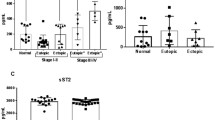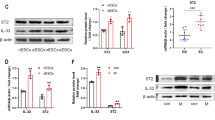Abstract
In endometriosis, M2 macrophages (MΦ) are dominant and promote the development of endometriosis lesions. However, the factor(s) which induces M2 MΦ are unknown. In the present study, we focused on interleukin (IL)-33, known as an alarmin and investigated its expression and its role in endometriosis, especially from the point of the relevance with MΦ. The expression of IL-33 in endometriosis lesions was examined by immunohistochemistry. The cystic fluid of ovarian cysts/tumors was obtained and used to measure IL-33 concentration. Endometriotic stromal cells (ESC) and MΦ derived from patients were used for in vitro experiments. IL-33 was detected in the epithelium and stromal cells of endometriotic lesions. The mean IL-33 concentration in the cystic fluid of endometriomas was significantly higher than that in non-endometriomas (2.2 ng/ml vs. 0.02 ng/ml, P < 0.01). IL-1β induced IL-33 mRNA expression in ESC via p38 MAPK activation. With IL-33 stimulation, peritoneal MΦ polarized to M2 MΦ and produced IL-1β mRNA with a 2.2-fold increase, which was negated with soluble ST2, a decoy receptor of IL-33. IL-33, derived from endometriotic lesions, stimulated MΦ to produce IL-1β, which results in increasing IL-33 production in ESC. This cycle may continue to exacerbate the endometriotic lesions.






Similar content being viewed by others
References
Zondervan KT, Becker CM, Koga K, Missmer SA, Taylor RN, Viganò P. Endometriosis. Nat Rev Dis Prim. 2018;4(1):9.
Sampsons S, et al. Peritoneal endometriosis due to the menstrual dissemination of endometrial tissue into the peritoneal cavity. Am J Obstet Gynecol. 1927;14:422–69.
Chuang PC, Wu MH, Shoji Y, Tsai SJ. Downregulation of CD36 results in reduced phagocytic ability of peritoneal macrophages of women with endometriosis. J Pathol. 2009 Oct;219(2):232–41.
Capobianco A, Rovere-Querini P. Endometriosis, a disease of the macrophage. Front Immunol. 2013;28(4):9.
Itoh F, et al. Possible involvement of signal transducer and activator of transcription-3 in cell-cell interactions of peritoneal macrophages and endometrial stromal cells in human endometriosis. Fertil Steril. 2013;99(6):1705–13.
Chacho KJ, et al. Peritoneal fluid in patients with and without endometriosis: prostanoid and macrophages and their effect on the spermatozoa penetration assay. Am J Obstet Gynecol. 1986;154:1290–9.
Khan KN, Kitajima M, Hiraki K, Fujishita A, Sekine I, Ishimaru T, et al. Immunopathogenesis of pelvic endometriosis: role of hepatocyte growth factor, macrophages and ovarian steroids. Am J Reprod Immunol. 2008 Nov;60(5):383–404.
Borrelli GM, Abrão MS, Mechsner S. Can chemokines be used as biomarkers for endometriosis? A systematic review. Hum Reprod. 2014;29(2):253–66.
Gordon S, Martinez FO. Alternative activation of macrophages: mechanism and functions. Immunity. 2010;32(5):593–604.
Bacci M, Capobianco A, Monno A, Cottone L, Di Puppo F, Camisa B, et al. Macrophages are alternatively activated in patients with endometriosis and required for growth and vascularization of lesions in a mouse model of disease. Am J Pathol. 2009;175(2):547–56.
Liew FY, Girard JP, Turnquist HR. Interleukin-33 in health and disease. Nat Rev Immunol. 2016;16(11):676–89.
Griesenauer B, Paczesny S. The ST2/IL-33 axis in immune cells during inflammatory diseases. Front Immunol. 2017;8:475.
Santulli P, Borghese B, Chouzenoux S, Vaiman D, Borderie D, Streuli I, et al. Serum and peritoneal interleukin-33 levels are elevated in deeply infiltrating endometriosis. Hum Reprod. 2012;27(7):2001–9.
He R, Yin H, Yuan B, Liu T, Luo L, Huang P, et al. IL-33 improves wound healing through enhanced M2 macrophage polarization in diabetic mice. MolImmunol. 2017;90:42–9.
Wang C, Dong C, Xiong S. IL-33 enhances macrophage M2 polarization and protects mice from CVB3-induced viral myocarditis. J Mol Cell Cardiol. 2017;103:22–30.
Acknowledgments
We thank Dr. Heather M. Martinez for her helpful discussion and critical reading of the manuscript.
Funding
This work was supported by Health and Labor Sciences Research Grants from the Ministry of Health, Labor and Welfare of Japan, Grant-in-Aid for Scientific Research from the Ministry of Education, Culture, Sports, Science, and Technology.
Author information
Authors and Affiliations
Corresponding author
Ethics declarations
Declaration of Interest
The authors declare that they have no conflict of interest.
Rights and permissions
About this article
Cite this article
Ono, Y., Yoshino, O., Hiraoka, T. et al. IL-33 Exacerbates Endometriotic Lesions via Polarizing Peritoneal Macrophages to M2 Subtype. Reprod. Sci. 27, 869–876 (2020). https://doi.org/10.1007/s43032-019-00090-9
Received:
Accepted:
Published:
Issue Date:
DOI: https://doi.org/10.1007/s43032-019-00090-9




